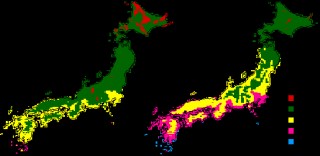Loading
Search
▼ Long-term vision needed to deal with projected damage from global warming
- Category:Other

THE JAPAN NEWS
If Japan’s climate continues to warm at its present rate, the nation will not only find itself facing more frequent natural disasters, but there also will be massive repercussions for people’s everyday lives as a whole. Devising effective measures to minimize the damage is a pressing task.
The Environment Ministry has released a draft report on the estimated impact of global warming on the nation by the end of this century. Based on this report, the government will settle this summer for the first time on a plan for “adaptive steps” aimed at reducing the damage likely to be caused by higher temperatures.
International efforts to counter global warming have centered on reducing emissions of greenhouse gases. Of course, cutting these emissions is important. However, even if these reductions are made, the projection is that warmer temperatures will be unavoidable to some extent. In international negotiations on this matter, greater emphasis is being attached to improving measures for effectively adapting to global warming.
The government’s compilation of its own adaptive steps is indeed timely.
The draft report was based on the findings of experts who pored over more than 500 theses and other academic works to assess the level of damage likely to result in Japan. They examined the magnitude of the likely impact, the urgency of countermeasures and the veracity of climate change projections. Measures are quickly required in fields including health and agriculture, and dealing with natural disasters.
There is concern about increased flooding and storm surges generated by powerful typhoons and frequent heavy rain. More landslide disasters like the one that struck Hiroshima in the summer of 2014 could occur.
Limits to infrastructure
There are limits to the effectiveness of hardware involving infrastructure, such as seawalls all around the nation. Living in at-risk areas should be restricted. The accuracy of forecasts for localized torrential rain and typhoon paths should be improved, and people urged to evacuate ahead of time. This kind of “soft infrastructure” will become more important in efforts to protect people’s lives.
There are concerns that cases of heatstroke will increase, especially among elderly people. We would like to see more greenery in urban areas to help counter the so-called heat island effect.
In the agricultural sector, the impact will be massive, especially on rice cultivation. The proportion of top-grade rice — rice of a high quality — is forecast to decline across the country. If reductions in greenhouse gas emissions do not go far enough and Japan’s average temperature increases by more than 3 C, rice crop yields will shrink in regions except for northern Japan.
Controlling pests and nonnative weeds also will become more important than ever. There are fears that in addition to a drop in snowfall, the decline in water that comes when the snow melts could create a shortage of water for agricultural use during the rice-planting season and at other times. This could threaten the foundation of the production of this staple food.
Many of the regions where apples and mikan mandarin oranges are grown will apparently become unsuitable for cultivating these fruits in the 2060s.
Signs of high-temperature damage in Onshu mikan have already appeared in Ehime Prefecture. Some farmers there have received support from research laboratories and other entities in the prefecture to begin growing oranges native to Italy.
Developing varieties of produce able to withstand hotter temperatures, and switching to different crops will become vital. Research institutes and local governments will need to work closely with farmers to devise farming plans that suit the actual conditions of each region.
- January 23, 2015
- Comment (0)
- Trackback(0)

